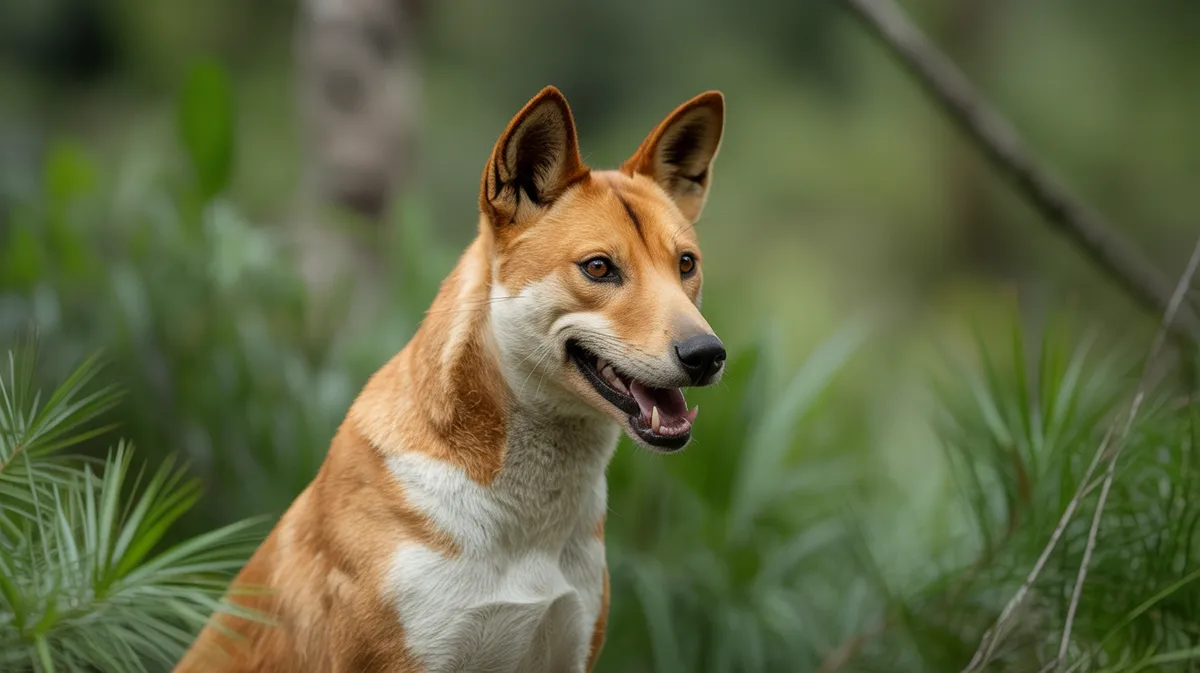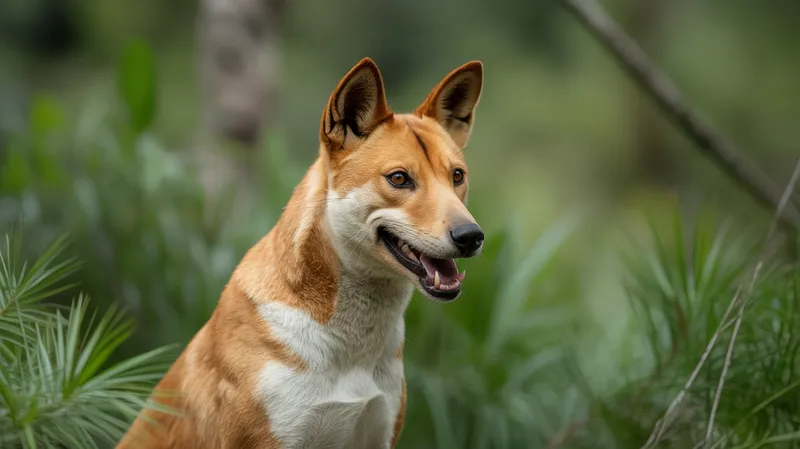
New Guinea Singing Dog
Canis lupus dingo

Meet the New Guinea Singing Dog
The New Guinea Singing Dog is a rare, small wild canid native to the highlands of New Guinea. Renowned for its unique and melodious vocalizations, this dog exhibits a wide range of harmonic sounds that are unlike those of any other canine. It has a fox-like appearance with a reddish-gold coat, erect ears, and a bushy tail, and is highly agile, able to climb and navigate rugged terrain with ease. Once thought extinct in the wild, a few individuals have been rediscovered in remote areas, though they remain critically endangered.
Classification
Mammal
Habitat
Mountain forests
Diet
Carnivore
Lifespan
12-15 years
Conservation
Critically Endangered
Weight
9-14 kg
📖Fascinating Facts
Unique Singer
The New Guinea Singing Dog produces harmonic, melodious vocalizations unlike any other canid, giving it its name.
Mountain Specialist
This dog is specially adapted to the dense mountain forests of New Guinea, exhibiting exceptional climbing and jumping abilities.
Wild Origins
Although related to the Australian dingo, the New Guinea Singing Dog is a distinct population that has remained isolated for thousands of years.
📋Detailed Description
The New Guinea Singing Dog (Canis lupus dingo or Canis lupus hallstromi) is a small, agile canid with a distinctive, fox-like appearance. Adults typically measure 32–46 cm (13–18 in) at the shoulder and weigh between 8–15 kg (18–33 lbs). Their dense, double-layered coat is usually a rich golden red, sometimes with white markings on the chest, feet, and tail tip. The face is characterized by a narrow muzzle, almond-shaped amber eyes, and large, upright, triangular ears that are highly mobile and contribute to acute hearing. Their bushy tail is often carried curled over the back. Anatomically, they possess flexible joints and a unique shoulder structure, allowing them to climb trees and navigate steep, rocky terrain with remarkable agility—a rare trait among wild canids. The New Guinea Singing Dog is renowned for its unique vocalizations, which include complex harmonic howls, yodels, and trills, earning it the 'singing' moniker. These vocalizations are used in social communication and may play a role in territory establishment. In the wild, they are elusive and primarily crepuscular, being most active at dawn and dusk. Their diet consists mainly of small mammals, birds, and reptiles, supplemented by insects and occasional plant matter. Socially, they are often observed alone or in pairs, but may form small family groups. Breeding pairs are monogamous, and both parents participate in rearing the young. The species is critically endangered, with only a handful of confirmed wild populations and a small captive population maintained for conservation.
💡 Did you know?
Unlike domestic dogs, the New Guinea Singing Dog’s joints and spine are unusually flexible, enabling it to climb and leap with great agility.
🔬Research & Sources
Wikipedia Summary
The New Guinea singing dog or New Guinea Highland dog is an ancient (basal) lineage of dog found in the New Guinea Highlands, on the island of New Guinea. Once considered to be a separate species in its own right, under the name Canis hallstromi, it is closely related to the Australian dingo. The dog is relatively unusual among canines; it is one of the few to be considered "barkless", and is known for the unusual "yodel"-like style of vocalizing that gives it its name.
Last Modified: 5/25/2025
🎭Behavior & Social Structure
New Guinea Singing Dogs are highly intelligent and display a wide range of behaviors adapted to their mountainous habitat. They are solitary or form small, tight-knit groups, typically consisting of a mated pair and their offspring. Unlike many domestic dogs, they exhibit minimal barking, instead communicating through a repertoire of howls, yodels, and whines. Their hunting strategy relies on stealth and agility; they stalk and pounce on prey such as rodents, birds, and lizards. They are known to cache surplus food and have been observed climbing trees to escape predators or access prey. Daily activity peaks during twilight hours, with individuals resting in sheltered dens during the heat of the day. Social interactions involve ritualized greeting behaviors, mutual grooming, and play, particularly among juveniles. Territorial marking is performed using scent, and vocalizations are used to maintain territory boundaries and coordinate with group members.
👶Reproduction & Life Cycle
Breeding in New Guinea Singing Dogs typically occurs once a year, with the season varying depending on environmental conditions but often coinciding with the dry season (June–August). Females come into estrus for approximately 8–10 days. After successful mating, gestation lasts about 63 days. Litters usually consist of 2–4 pups, though up to 6 have been recorded. Pups are born blind and helpless in secluded dens, and both parents participate in their care. The female nurses the pups for up to 8 weeks, while the male provides food and protection. Weaning begins at around 6 weeks, and pups start to accompany adults on hunting forays by 10–12 weeks. Sexual maturity is reached at around 2 years of age. In captivity, reproductive rates are low, possibly due to inbreeding depression and limited genetic diversity.
🛡️Adaptations & Survival
New Guinea Singing Dogs exhibit several unique adaptations to their highland environment. Their flexible spine and limb joints enable them to leap, climb, and maneuver through dense forest and rocky outcrops, a trait uncommon in other canids. Their acute senses of hearing and smell aid in detecting prey and avoiding predators. The dense, weather-resistant coat provides insulation against the cool, damp mountain climate. Vocal adaptations include the ability to produce a wide range of harmonic sounds, which may help individuals communicate over long distances in rugged terrain. Their metabolic efficiency allows them to survive on limited food resources, and their opportunistic diet includes both animal and plant matter. Behavioral flexibility, such as caching food and utilizing a variety of den sites, further enhances survival in a challenging environment.
📚Research Sources
🎨Cultural Significance
While not as deeply embedded in local mythology as the dingo is in Australia, the New Guinea Singing Dog has been recognized by indigenous highland communities for its unique vocalizations and elusive nature. Some traditional stories reference wild dogs as clever and resourceful animals. In the mid-20th century, the species gained international attention when specimens were brought to Western zoos and research institutions. Today, it holds symbolic value as a living link to the early domestication of dogs and as a flagship species for conservation in New Guinea. There are no widespread traditional uses, but the animal is sometimes regarded with curiosity and respect by local peoples.
🔬Recent Research & Discoveries
Recent genetic studies have clarified the evolutionary history of the New Guinea Singing Dog, confirming its close relationship to the Australian dingo and its status as a basal lineage of domestic dog. A landmark 2020 study used genomic analysis to compare captive and wild populations, revealing that wild-living singing dogs in Papua are genetically distinct but closely related to the captive population, supporting their status as a unique taxon. Ongoing research focuses on vocalization patterns, ecological requirements, and the impact of hybridization with domestic dogs. Conservation genetics is a key area of study, with efforts underway to increase genetic diversity in captive breeding programs. Field surveys using camera traps and environmental DNA are being employed to locate and monitor wild populations.
🎥Wildlife Videos

Wild Animal Weekend: New Guinea Singing Dogs
Wild Animal Safari Inc

Nature Dogs That Changed the World The Rise of the Dog
陶钧辉

World's Rarest Wild 'Singing' Dog, thought to be extinct in wild for 50 years, Reemerged!
An extremely rare breed of 'singing' dog, thought to have been extinct, has been spotted in its natural habitat for the first time in 50 ...
World's Amazing Stories

Dogs 101 New Guine singing dog ENG
DENSE DOUBLE COAT ...
Animal Movie & show clips

Ancient Wild Dog Population Feared Extinct, Now Captured on Camera | National Geographic
The New Guinea highland wild dog was feared extinct in the wild after nearly half a century without a confirmed sighting. But after ...
National Geographic

New Guinea Singing Dog Pros and Cons | New Guinea Highland Dog Advantages and Disadvantages
The New Guinea singing dog or New Guinea Highland dog is an ancient] lineage of dog found in the New Guinea Highlands, ...
Animal Platoon
🌍Habitat Information
The New Guinea Singing Dog typically inhabits Mountain forests environments. New Guinea Singing Dogs have adapted to their environments with specialized features and behaviors.
Primary Habitat:
Mountain forests
More detailed habitat information will be available soon.
🛡️Conservation Status
The New Guinea Singing Dog is currently classified as Critically Endangered. Conservation efforts are crucial for preserving this species for future generations.
Common Threats:
- 🏠Habitat loss and fragmentation
- 🌡️Climate change impacts
- 🎯Hunting and poaching
- 🏭Human-wildlife conflict
⚠️Threats & Conservation Challenges
The primary threats to the New Guinea Singing Dog are habitat loss due to agricultural expansion, hunting, and hybridization with domestic and feral dogs, which dilutes the genetic integrity of the wild population. Disease transmission from domestic dogs also poses a significant risk. The species was once thought extinct in the wild, but small, isolated populations have been rediscovered in remote areas of Papua, Indonesia. However, these populations are extremely vulnerable due to their small size and genetic bottleneck. Conservation challenges include the difficulty of accessing remote habitats for study, the lack of comprehensive population surveys, and limited public awareness. Captive populations suffer from low genetic diversity, making long-term viability a concern. Population trends remain uncertain, but the overall outlook is precarious without targeted conservation action.
🔬Scientific Classification
Scientific Name
Canis lupus dingo
Classification Hierarchy
🔍 About Taxonomic Classification
Taxonomic classification is a hierarchical system used by scientists to classify and organize living organisms based on shared characteristics and evolutionary relationships.
The system moves from broad categories (Kingdom) to increasingly specific ones, with each animal's scientific name typically consisting of its Genus and species.
📝Community Notes
Share your observations and insights about the New Guinea Singing Dog with our community of wildlife enthusiasts.
Join Our Community
Sign in to share your observations and connect with fellow wildlife enthusiasts.
Sign In to ContributeNo community notes yet
Be the first to share your observations about the New Guinea Singing Dog!
Explore New Guinea Singing Dog
Select a tab above to learn more about this amazing animal.
📸Photo Gallery
No photos available for this animal yet.
🌟Discover More Wildlife
Continue your journey of discovery with more fascinating animals from our database
